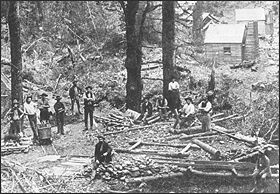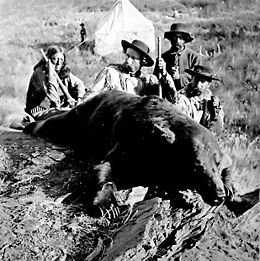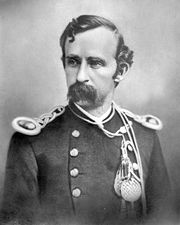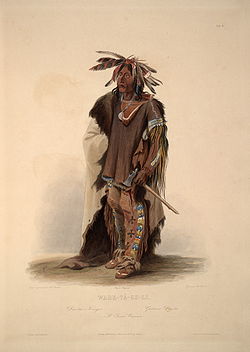
Custer's 1874 Black Hills Expedition
Encyclopedia

United States Army
The United States Army is the main branch of the United States Armed Forces responsible for land-based military operations. It is the largest and oldest established branch of the U.S. military, and is one of seven U.S. uniformed services...
expedition in 1874 led by Lieutenant Colonel
Lieutenant colonel
Lieutenant colonel is a rank of commissioned officer in the armies and most marine forces and some air forces of the world, typically ranking above a major and below a colonel. The rank of lieutenant colonel is often shortened to simply "colonel" in conversation and in unofficial correspondence...
George Armstrong Custer
George Armstrong Custer
George Armstrong Custer was a United States Army officer and cavalry commander in the American Civil War and the Indian Wars. Raised in Michigan and Ohio, Custer was admitted to West Point in 1858, where he graduated last in his class...
that set out on July 2, 1874 from modern day Bismarck, North Dakota
Bismarck, North Dakota
Bismarck is the capital of the U.S. state of North Dakota and the county seat of Burleigh County. It is the second most populous city in North Dakota after Fargo. The city's population was 61,272 at the 2010 census, while its metropolitan population was 108,779...
, which was then Fort Abraham Lincoln
Fort Abraham Lincoln
Fort Abraham Lincoln State Park is located seven miles south of Mandan, North Dakota. The park is home to On-A-Slant Indian Village, the blockhouses and the Custer house...
in the Dakota Territory
Dakota Territory
The Territory of Dakota was an organized incorporated territory of the United States that existed from March 2, 1861, until November 2, 1889, when the final extent of the reduced territory was split and admitted to the Union as the states of North and South Dakota.The Dakota Territory consisted of...
, with orders to travel to the previously uncharted Black Hills
Black Hills
The Black Hills are a small, isolated mountain range rising from the Great Plains of North America in western South Dakota and extending into Wyoming, USA. Set off from the main body of the Rocky Mountains, the region is something of a geological anomaly—accurately described as an "island of...
of South Dakota
South Dakota
South Dakota is a state located in the Midwestern region of the United States. It is named after the Lakota and Dakota Sioux American Indian tribes. Once a part of Dakota Territory, South Dakota became a state on November 2, 1889. The state has an area of and an estimated population of just over...
. Its mission was to look for suitable locations for a fort, find a route to the southwest, and to investigate the possibility of gold mining. Custer and his unit, the 7th Cavalry, arrived in the Black Hills on July 22, 1874, with orders to return by August 30. The expedition set up a camp at the site of the future town of Custer
Custer, South Dakota
Custer is a city in Custer County, South Dakota, United States. The population was 2,067 at the 2010 census. It is the county seat of Custer County.-History:...
; while Custer and the military units searched for a suitable location for a fort, civilians searched for gold, and found clear evidence in a creek near the camp. This prompted a mass gold rush
Gold rush
A gold rush is a period of feverish migration of workers to an area that has had a dramatic discovery of gold. Major gold rushes took place in the 19th century in Australia, Brazil, Canada, South Africa, and the United States, while smaller gold rushes took place elsewhere.In the 19th and early...
which in turn antagonised the Sioux
Sioux
The Sioux are Native American and First Nations people in North America. The term can refer to any ethnic group within the Great Sioux Nation or any of the nation's many language dialects...
Indians who had been promised the land (which they saw as sacred) by the US government, and who were later to kill Custer at the Battle of the Little Big Horn when their antagonism erupted into the Great Sioux War of 1876-77
Great Sioux War of 1876-77
The Great Sioux War of 1876, also known as the Black Hills War, was a series of battles and negotiations which occurred between 1876 and 1877 involving the Lakota and Northern Cheyenne, against the United States...
between themselves and the United States.
The entire expedition was photographed by William H. Illingworth
William H. Illingworth
William H. Illingworth was an English photographer who accompanied both Captain James L. Fisk's 1866 expedition to the Montana Territory and Lt. Colonel George Custer's 1874 U.S. military expedition into the Black Hills of the Dakota Territory .- Early life :William Henry Illingworth was born in...
, an English
English people
The English are a nation and ethnic group native to England, who speak English. The English identity is of early mediaeval origin, when they were known in Old English as the Anglecynn. England is now a country of the United Kingdom, and the majority of English people in England are British Citizens...
photographer who accompanied Custer after selection by the then-Captain William Ludlow
William Ludlow
William Ludlow was an officer in the Corps of Engineers and a major general in the United States Army who served in the Civil War, Plains Indian Wars, the Spanish-American War, and led a scientific expedition examining the natural wonders of Yellowstone National Park.-Early life:Ludlow was born in...
. Ludlow, the engineer for the expedition, financed Illingworth's photography and paid him $30 per month to provide photographic plates for the US Army, of which he made 70 in all.
Embarking for the Black Hills
Custer embarked on his expedition with 1000-1200 men, in 110 wagons with numerous horses and cattle of the 7th cavalry, along with artillery and two months food supply. The expedition also took a number of Native AmericanNative Americans in the United States
Native Americans in the United States are the indigenous peoples in North America within the boundaries of the present-day continental United States, parts of Alaska, and the island state of Hawaii. They are composed of numerous, distinct tribes, states, and ethnic groups, many of which survive as...
scouts led by Bloody Knife and Lean Bear. At the time, the Black Hills were relatively unknown, with few white expeditions ever returning from them The commander of Custer's engineering corps, Captain Hardy, assured him that he had heard of them and had them marked on his maps, but had never entered them during his earlier expeditions. En route to the Black Hills, Custer's party managed to locate the track of Hardy's group when they spotted two lines of sunflowers that had grown along the ruts of his passing wagons.
Custer and his force entered the Black Hills from the north, travelling south at a slow pace of no more than four or five miles a day on some occasions. On July 31, 1874, the wagon train reached Harney Peak
Harney Peak
Harney Peak is the highest natural point in South Dakota. Harney Peak is located within the Black Elk Wilderness area, in southern Pennington County, within Black Hills National Forest...
, and Custer together with Ludlow took three or four men to climb it. In the mean time, the rest of the expedition made camp at the mountain's base at the newly-named Custer Park. While the majority of the force remained there, Custer took a small unit with him to locate a suitable site for a new fort. By August 2, 1874 this force had reached a point eight and a half miles south-east of the mountain, to a location they named Agnes Park, having had a number of peaceful encounters with native American settlements. On August 7 Custer shot and killed a grizzly bear
Grizzly Bear
The grizzly bear , also known as the silvertip bear, the grizzly, or the North American brown bear, is a subspecies of brown bear that generally lives in the uplands of western North America...
, forever claiming this to be his greatest achievement as a hunter.
Discovery of gold

Charley Reynolds
"Lonesome" Charley Reynolds was a scout in the U.S. 7th Cavalry Regiment who was killed at the Battle of the Little Bighorn in the Montana Territory. He was noted as an expert marksman, frontiersman and hunter. He had also been a scout with Buffalo Bill.-Biography:Charles Alexander Reynolds was...
to Fort Laramie, and from there it was telegraphed to the press eastwards.
The force remained there at Agnes Park until August 15 whereupon it turned around to return to Fort Lincoln. The expedition returned on August 30, with the scouts returned to their reservations on September 10. In total, Custer and his forces had travelled for 60 days over 883 miles.
Organization of the 7th Cavalry
The table of organisation for the 7th Cavalry for the Black Hills Expedition of 1874 was as follows.- Field and staff
- Lt. Colonel George Armstrong CusterGeorge Armstrong CusterGeorge Armstrong Custer was a United States Army officer and cavalry commander in the American Civil War and the Indian Wars. Raised in Michigan and Ohio, Custer was admitted to West Point in 1858, where he graduated last in his class...
- Lt. Colonel Frederick D. GrantFrederick Dent GrantFrederick Dent Grant was a soldier and United States minister to Austria-Hungary. Grant was the first son of General of the Army and President of the United States Ulysses S. Grant and Julia Grant. He was named after his uncle, Frederick Tracy Dent...
, 4th cavalry and acting aide - Major George A. ForsythGeorge Alexander ForsythGeorge Alexander Forsyth was a United States military officer most notable for his service in the cavalry.-Early life:Forsyth was born in Muncy, Pennsylvania...
, 9th cavalry commander - First Lieutenant James CalhounJames Calhoun (soldier)James Calhoun was a soldier in the United States Army during the American Civil War and the Black Hills War...
, adjutant - First Lieutenant Algernon E. SmithAlgernon SmithAlgernon Emory Smith was an officer in the U.S. 7th Cavalry Regiment who was killed in the Battle of the Little Bighorn in the Montana Territory....
, quartermaster - Second Lieutenant George D. Wallace, commander of the Indian scouts
- Lt. Colonel George Armstrong Custer

- Cavalry companies
- Company A - Captain Myles Moylan and Second Lieutenant Charles VarnumCharles VarnumCharles Albert Varnum was a career United States Army officer. He was most noted as the commander of the scouts for George Armstrong Custer in the Little Bighorn Campaign during the Black Hills War, as well as receiving the Medal of Honor for his actions in a conflict following the Battle of...
- Company B - First Lieutenant Benjamin H. Hodgeson
- Company C - Captain Verlin Hart and Second Lieutenant Henry M. HarringtonHenry Moore HarringtonHenry Moore Harrington was a military officer in the U.S. 7th Cavalry Regiment who perished with George Armstrong Custer at the Battle of Little Big Horn in the Montana Territory....
- Company E - First Lieutenant M. McDougall
- Company F - Captain George W. YatesGeorge Yates*Classic Battles: Little Big Horn 1876, Peter Panzieri, ISBN 1-85532-458-X*Crazy Horse and Custer, Stephen E. Ambrose, 1975, ISBN 0-385-47966-2*Cavalier in Buckskin, Robert M. Utley, 1988, ISBN 0-8061-2150-5...
- Company G - First Lieutenant Donald McIntoshDonald McIntoshDonald McIntosh was an officer in the U.S. 7th Cavalry Regiment who was killed at the Battle of Little Big Horn in the Montana Territory.-Biography:...
- Company H - Captain Frederick W. BenteenFrederick BenteenFrederick William Benteen was a military officer during the American Civil War and then during the Black Hills War against the Lakota and Northern Cheyenne. He is notable for being in command of a battalion of the 7th U. S...
and First Lieutenant Francis M. Gibson - Company K - Captain Owen Hale and First Lieutenant Edward S. GodfreyEdward Settle GodfreyEdward Settle Godfrey was a United States Army Brigadier General who received the Medal of Honor for leadership as a captain during the Indian Wars.-Early life and education:...
- Company L - First Lieutenant Thomas W. CusterThomas CusterThomas Ward Custer was a United States Army officer and two-time recipient of the Medal of Honor for bravery during the American Civil War...
- Company M - Captain Thomas French and First Lieutenant Edward Gustave Mathey
- Company A - Captain Myles Moylan and Second Lieutenant Charles Varnum

- Medical staff
- Dr. John W. Williams, chief medical officerChief Medical OfficerThere are four Chief Medical Officers in the United Kingdom who are appointed to advise their respective governments on health related matters: Her Majesty's Government, the Northern Ireland Executive, the Scottish Government and the Welsh Assembly Government...
- Dr. S. J. Allen, Jr. assistant surgeon
- Dr. A. C. Bergen, assistant surgeon
- Dr. John W. Williams, chief medical officer
- Engineering
- Captain William LudlowWilliam LudlowWilliam Ludlow was an officer in the Corps of Engineers and a major general in the United States Army who served in the Civil War, Plains Indian Wars, the Spanish-American War, and led a scientific expedition examining the natural wonders of Yellowstone National Park.-Early life:Ludlow was born in...
, chief engineer - W. H. Wood, civilian assistant
- Captain William Ludlow
- Mining detachment
- Horatio Nelson Ross
- William McKay
- Scientist
- George Bird GrinnellGeorge Bird GrinnellGeorge Bird Grinnell was an American anthropologist, historian, naturalist, and writer. Grinnell was born in Brooklyn, New York, and graduated from Yale University with a B.A. in 1870 and a Ph.D. in 1880. Originally specializing in zoology, he became a prominent early conservationist and student...
- Newton H. Winchell
- A. B. Donaldson
- Luther North
- George Bird Grinnell
- Photographer
- William H. IllingworthWilliam H. IllingworthWilliam H. Illingworth was an English photographer who accompanied both Captain James L. Fisk's 1866 expedition to the Montana Territory and Lt. Colonel George Custer's 1874 U.S. military expedition into the Black Hills of the Dakota Territory .- Early life :William Henry Illingworth was born in...
- William H. Illingworth
- Correspondents
- William E. Curtis, Chicago Inter-Ocean
- Samuel J. BarrowsSamuel J. BarrowsSamuel June Barrows was a U.S. Representative from Massachusetts.He was born in New York City. After his father died at a young age, he was relied upon to support his family by working for a printing press. Due to illness, he was rejected by the United States Navy and didn't serve in the American...
, New York TribuneNew York TribuneThe New York Tribune was an American newspaper, first established by Horace Greeley in 1841, which was long considered one of the leading newspapers in the United States... - Nathan H. Knappen, Bismarck TribuneBismarck TribuneThe Bismarck Tribune is a daily newspaper printed in Bismarck, North Dakota. The Tribune is the primary daily newspaper for south-central and southwest North Dakota. Its average daily circulation is 31,081 on Sundays and 27,620 on weekdays. One notable reporter for the paper was Mark H...

